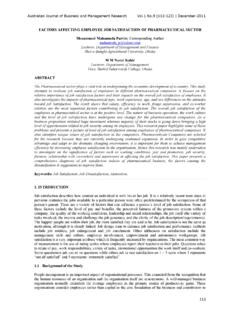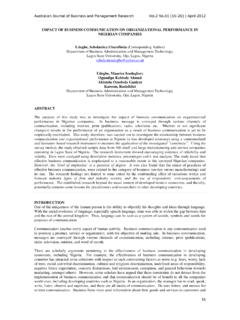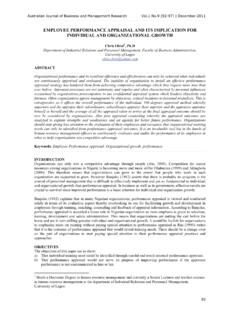Transcription of EFFECTS OF LEADERSHIP STYLE ON ORGANIZATIONAL …
1 Australian Journal of Business and Management Research [100-111] | October-2011 100 EFFECTS OF LEADERSHIP STYLE ON ORGANIZATIONAL PERFORMANCE: A SURVEY OF SELECTED SMALL SCALE ENTERPRISES IN IKOSI-KETU COUNCIL DEVELOPMENT AREA OF LAGOS STATE, NIGERIA Obiwuru Timothy C. Department of Actuarial Science University of Lagos, Nigeria Okwu, Andy T. (Corresponding Author) Department of Economics, Banking and Finance Babcock University, Nigeria E-mail: Akpa, Victoria O. Department of Business Administration and Marketing Babcock University, Nigeria Nwankwere, Idowu A. Department of Business Administration and Marketing Babcock University, Nigeria ABSTRACT This study has investigated the EFFECTS of LEADERSHIP STYLE on ORGANIZATIONAL performance in small scale enterprises.
2 The major objective was to determine effect of LEADERSHIP styles on performance in small scale enterprises. Transformational and transactional LEADERSHIP styles were considered in this study. Transformational LEADERSHIP behaviours and performance/outcome considered relevant in the study were charisma, inspirational motivation and intellectual stimulation/individual consideration; and effectiveness, extra effort and satisfaction, respectively. Transactional LEADERSHIP bahaviours and performance/outcome variables were constructive/contingent reward and corrective/management by exception; and effort, productivity and loyalty/commitment, respectively. The study followed a survey design, and employed evaluative quantitative analysis method.
3 Analysis was based on primary data generated through a structured Multifactor LEADERSHIP Questionnaire (MLQ) administered on respondents. Responses to research statements were scaled and converted to quantitative data via code manual developed for the study to enable segmentation of the data responses into dependent and independent variables based on LEADERSHIP behaviours and associated performance variables. OLS multiple regression models were specified, estimated and evaluated. The result showed that while transactional LEADERSHIP STYLE had significant positive effect on performance, transformational LEADERSHIP STYLE had positive but insignificant effect on performance.
4 The study concluded that transactional LEADERSHIP STYLE was more appropriate in inducing performance in small scale enterprises than transformational LEADERSHIP STYLE and, therefore, recommended transactional LEADERSHIP STYLE for the small enterprises with inbuilt strategies for transition to transformational LEADERSHIP STYLE as the enterprises developed, grew and matured. Keywords: LEADERSHIP STYLE , EFFECTS , Performance, Small Scale Enterprise 1. INTRODUCTION The concept and definition of LEADERSHIP and STYLE may differ from one person, or situation, to the other. The word LEADERSHIP has been used in various aspects of human endeavour such as politics, businesses, academics, social works, etc.
5 Previous views about LEADERSHIP show it as personal ability. Messick and Kramer (2004) argued that the degree to which the individual exhibits LEADERSHIP traits depends not only on his characteristics and personal abilities, but also on the characteristics of the situation and environment in which he finds himself. Since human beings could become members of an organization in other to achieve certain personal objectives, the extent to which they are active members depends on how they are convinced that their membership will enable them to achieve their predetermined objectives. Therefore, an individual will support an organization if he believes that through it his personal objectives and goals could be met; if not, the person s interest will decline.
6 LEADERSHIP STYLE in an organization is one of the factors that play significant role in enhancing or retarding the interest and commitment of the individuals in the organization. Thus, Glantz (2002) emphasizes the need for a manager to find his LEADERSHIP STYLE . Australian Journal of Business and Management Research [100-111] | October-2011 101 Among the objectives of any small enterprise are profit making and attainment of maturity and liquidity status. In the pursuit of these objectives, enterprises allocate scarce resources to competing ends. In the process they provide employment, provide goods and services, purchase goods and services and, thus, contribute to the growth of the society and economy at large.
7 Unamaka (1995) observes that in most Nigerian small-scale settings, the effectiveness of this process is greatly determined by the availability of and access to personnel, finance, machinery, raw material and possibility of making their goods and services available to their immediate community and the nation at large. The extent to which members of an organization contribute in harnessing the resources of the organization equally depends on how well the managers (leaders) of the organization understand and adopt appropriate LEADERSHIP STYLE in performing their roles as managers and leaders. Thus, efficiency in resources mobilization, allocation, utilization and enhancement of ORGANIZATIONAL performance depends, to a large extent, on LEADERSHIP STYLE , among other factors.
8 Akpala (1998) identifies attitude to work, LEADERSHIP STYLE and motivation as some of the factors that exert negative effect on ORGANIZATIONAL performance in Nigeria. Small and Medium Enterprise Development Agency of Nigeria (SMEDAN) in 2008, reports that most small and medium scale businesses in Nigeria die before their fifth anniversary. Ashibogwu (2008) notes that one of the reasons for this high failure is lack of use of market research to confirm demand and assess suitability of proposed offering as well as maintaining high level of customer patronage. Inappropriate LEADERSHIP STYLE could be one of the reasons for high failure of small enterprises. The study aligns with the concept of LEADERSHIP as explained by Taffinder (2006) and, thus, considers LEADERSHIP within the context of a small-scale enterprise as the action of managers of the enterprise to contribute their best to the purpose of the enterprise.
9 A small scale enterprise is one with relatively small number of employees and low capital strength. This study considers a small scale enterprise as one that has less than fifteen employees and whose capital outlay is less than three million naira. From this consideration, this study is intended to evaluate the effect of LEADERSHIP STYLE on the performance of small enterprises, contribute to empirical studies on LEADERSHIP STYLE and business performance, proffer quantitative-based recommendations for policies and programmes to reposition the small scale enterprises at integral part of the engine of economic growth and development in Nigeria. The study is divided into five sections.
10 Section one is the introduction, section two is a review of related literature, section three discusses the methodology employed in carrying out the study, and section four is data presentation and analysis, while section five concludes the study and proffers recommendations for policy and entrepreneurial decisions. 2. REVIEW OF RELATED LITERATURE LEADERSHIP STYLE and Performance In the literature, LEADERSHIP has been identified as an important subject in the field of ORGANIZATIONAL behaviour. LEADERSHIP is one with the most dynamic EFFECTS during individual and ORGANIZATIONAL interaction. In other words, ability of management to execute collaborated effort depends on LEADERSHIP capability.









